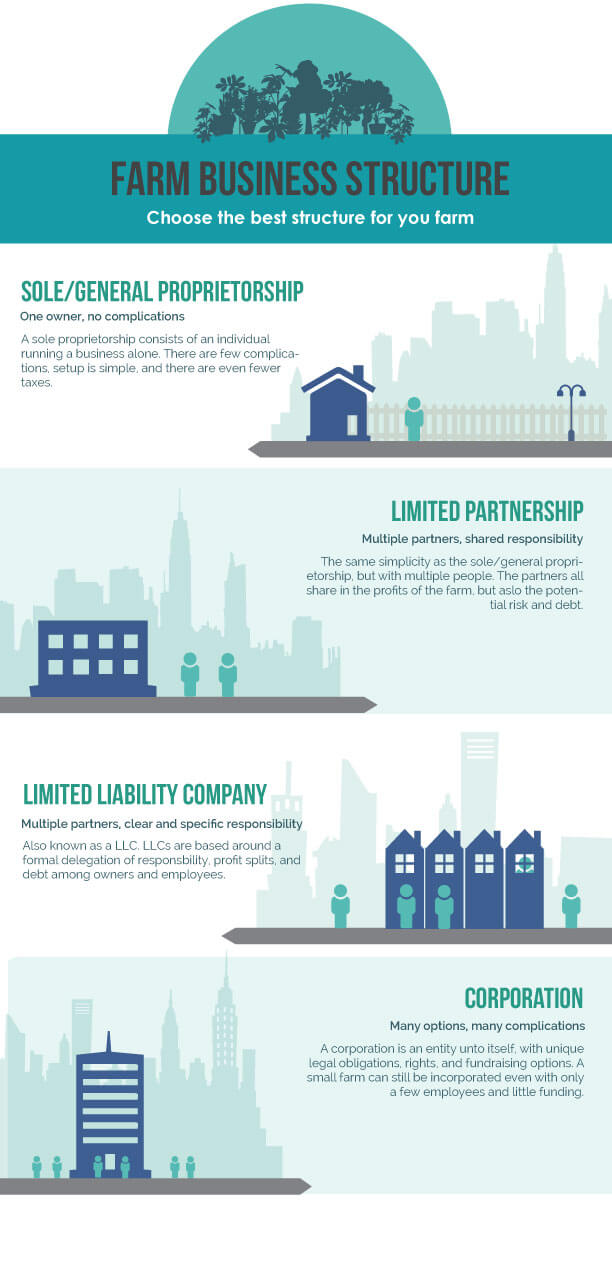Before a farmer even gets growing, they need a rock-solid business plan.
In addition to helping the farm secure funding, ensure profitability, and organize employees, the business plan serves another purpose: defining the business structure.
This article will break down some common business structures and make a few recommendations that we’ve seen work well for new farmers. We’ll also walk through a few pitfalls related to business structures which are common for farmers without business experience.

Why do new farmers need to think about business structure?
A common misconception about urban or indoor farming is the pastoral ideal—that the modern farmer doesn’t need to worry about business plans or loans, and can instead start a lifestyle free of those concerns.
Many new farmers dream of being their own boss, carefully tending to plants in a meet-cute fairy tale, feeding their friends and neighbors, and never reading an email again. While these dreams are indeed achievable, it’s important to remember: farming is a business.
New farmers need to accept that administration is necessary to run a successful business and keep your farm operational! We’ve written at great length about the necessity of careful planning, structured funding, and farm compliance, but we also wanted to cover how business structures are essential for starting an indoor farm.
*If you’re hiring an accountant or lawyer to aid in setting up your farm, they’ll be able to give you more specific information about business structure unique to your locale. Be sure to take their advice to heart.
Types of business structures
The first thing to keep in mind when discussing business structure is that each of these structures is beholden to a financial and legal structure. Think of these general examples as guidelines for ensuring compliance to accounting and legalities.
A common misconception is that certain business structures can insulate an owner from legal repercussion. This is not true, you are legally liable for anything for which your business can be held accountable. This myth comes from liability insurance, an insurance service that will cover your business in case of personal or legal liability. We, of course, recommend this insurance wholeheartedly, but the insurance is independent of any business structure.
With that out of the way, here are a few of the more common business structures used by small farmers:
Sole or General Proprietorship
This is the most straightforward and simple business structure. A sole proprietorship consists of an individual running a business alone. There are few complications, setup is simple, and there are even fewer taxes.
Limited Partnership
This business structure is very similar to a sole/general proprietorship, except with partners in the mix. The partners all share in the profits of the farm, but also the potential risk and debt.
Limited Liability Partnership
This partnership business structure is set up to specifically insulate partners from debt or liability incurred by other partners. Think of it as a more complicated but ultimately less risky form of a business partnership.
Corporation
A corporation goes beyond a traditional business structure. A new farmer’s corporation is an entity unto itself, with legal obligations, rights, and fundraising options unavailable to other business structures. Incorporating your farm is generally beyond the scope of most small farmers, but if you’re planning a large farm, consider discussing the benefits of starting a corporation with a lawyer.
Limited Liability Company
Also known as an LLC, this form of business structure is a common choice for small business owners. Much like a limited liability partnership, the LLC is based around a formal delegation of responsibility, profit splits, and debt among a number of partners and owners. An LLC has a heavy level of documentation for a small business. Consider this a benefit—not a hassle. Front-loading the legal work will make things much easier down the line.
Almost every business structure, excepting the sole/general proprietorship, will have to register with Secretary of State. Visit the Secretary of State’s Corporate Information Center to learn more about each business structure and what paperwork you’ll need to implement a structure for your farm.
Considerations for business structures
Before we recommend a specific business structure for new farmers, you should consider what you’ll require from your business structure.
To reiterate, business structures exist primarily to handle legal and accounting obligations. You’ll need clean, carefully organized account books to present to banks and potential investors, and a business structure is the foundation of those clean books.
While all farmers will have the tasks of growing and selling food in common, the practicalities of making that profit will differ based on capital, location, customer bases, and more. Before you select a business structure for your farm, consider:
- Will your farm be for profit or an educational center? Perhaps a nonprofit?
- Will you have partners? How many, and how will the responsibility and profit be split?
- How risky is your business plan? Will the risk of debt be significant enough to create safeguards to insulate your finances?
- What sort of taxation will your state levy on top of federal taxes? Will the financial burden be large enough to seek alternative models that are subject to fewer taxes?
- How many employees will your farm require to run?
Knowing your resources, strengths, and weaknesses will be essential to selecting a business structure.

Recommended farm business structures
After you’ve established the basics of your farm’s business plans, consider which of the above options will work best for your needs. With these needs in mind, we recommend you keep it simple: Start with a Sole/General Proprietorship.
There’s no additional risk by starting so small, and you won’t have to worry about cluttering your preliminary plans for starting a farm with unnecessary business structure and accounting. A sole/general proprietorship is the most straightforward option for starting a business as quickly as possible. Even if you’re concerned a sole/general proprietorship won’t offer enough options, you can always expand your business structure to a more complex option down the line with only a little additional work.
By starting with a sole proprietorship, you can take the first few steps to actually running a business. After forming the legal documentation for the proprietorship, you can then seek a federal employer ID, the second big step toward being recognized as a business. After you have those two steps covered, you can then approach a bank and open your first business account.
Running your business structure
Choosing a business structure is only the first step. After beginning the process, work closely with a lawyer to establish the basic legalities of your new farm. Begin hiring employees, securing funding, and making large equipment purchases. Establish clear guidelines and responsibilities with each of your business partners. Estimate costs, expenses, and required capital.
Don’t forget to visit Upstart University for classes on the widest variety of topics on running a farm, from market research to a comprehensive course on hydroponic farming.





Too bad that it is only for the US market!
I would think that there are students from different countries taking courses.
I’m from Bulgaria, which is a member of the EU. Where GMOs are banned.
As well as other regulations.
Just north of your border, the laws are different.
I find it concerned for the US market than the world.
It would be nice to find some true guidance, rather than being told I need to go find guidance. A new farm has no profits. I don’t see how we can really make much money initially, however selling produce, eggs, or other products produces a liability that would be best absorbed a corporation or LLC. It would seem any farmer selling direct to consumers would need that protection and liability insurance it’s so costly there is no way to begin a business with that huge expense.